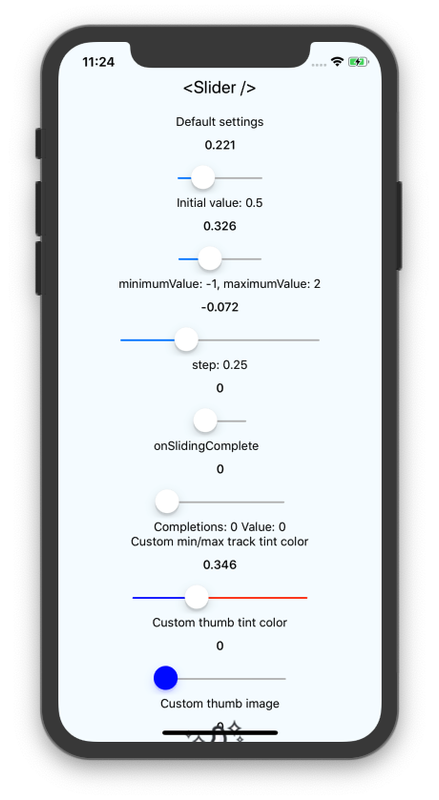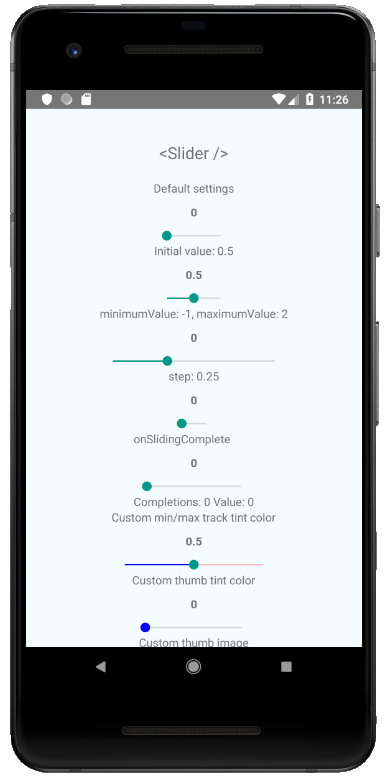callstack / React Native Slider
Programming Languages
@react-native-community/slider
React Native component used to select a single value from a range of values.
Getting started
yarn add @react-native-community/slider
or
npm install @react-native-community/slider --save
If using iOS, install cocoapods: npx pod-install
On Windows, autolinking is available from version 0.63. On 0.62 you need to manually link the module to your app.
You can see the example app's code for how to do it.
React Native Compatibility
To use this library you need to ensure you are using the correct version of React Native.
@react-native-community/slider version |
Required React Native Version |
|---|---|
4.x.x |
>=0.60; >=0.62 (on Windows); |
3.1.x |
>=0.60 |
2.x.x |
>= 0.60 |
1.x.x |
<= 0.59 |
Web support
For web support please use @react-native-community/[email protected]
Migrating from the core react-native module
This module was created when the Slider was split out from the core of React Native. To migrate to this module you need to follow the installation instructions above and then change you imports from:
import { Slider } from 'react-native';
to:
import Slider from '@react-native-community/slider';
Usage
Example
import Slider from '@react-native-community/slider';
<Slider
style={{width: 200, height: 40}}
minimumValue={0}
maximumValue={1}
minimumTrackTintColor="#FFFFFF"
maximumTrackTintColor="#000000"
/>
Check out the example project for more examples.
Props
styledisabledmaximumValueminimumTrackTintColorminimumValueonSlidingStartonSlidingCompleteonValueChangestepmaximumTrackTintColortestIDvalueinvertedtapToSeekverticalthumbTintColormaximumTrackImageminimumTrackImagethumbImagetrackImageref
style
Used to style and layout the Slider. See StyleSheet.js and ViewStylePropTypes.js for more info.
| Type | Required |
|---|---|
| View.style | No |
disabled
If true the user won't be able to move the slider. Default value is false.
| Type | Required |
|---|---|
| bool | No |
maximumValue
Initial maximum value of the slider. Default value is 1.
| Type | Required |
|---|---|
| number | No |
minimumTrackTintColor
The color used for the track to the left of the button. Overrides the default blue gradient image on iOS.
| Type | Required |
|---|---|
| color | No |
minimumValue
Initial minimum value of the slider. Default value is 0.
| Type | Required |
|---|---|
| number | No |
onSlidingStart
Callback that is called when the user picks up the slider. The initial value is passed as an argument to the callback handler.
| Type | Required |
|---|---|
| function | No |
onSlidingComplete
Callback that is called when the user releases the slider, regardless if the value has changed. The current value is passed as an argument to the callback handler.
| Type | Required |
|---|---|
| function | No |
onValueChange
Callback continuously called while the user is dragging the slider.
| Type | Required |
|---|---|
| function | No |
step
Step value of the slider. The value should be between 0 and (maximumValue - minimumValue). Default value is 0.
On Windows OS the default value is 1% of slider's range (from minimumValue to maximumValue).
| Type | Required |
|---|---|
| number | No |
maximumTrackTintColor
The color used for the track to the right of the button. Overrides the default gray gradient image on iOS.
| Type | Required |
|---|---|
| color | No |
testID
Used to locate this view in UI automation tests.
| Type | Required |
|---|---|
| string | No |
value
Initial value of the slider. The value should be between minimumValue and maximumValue, which default to 0 and 1 respectively. Default value is 0.
This is not a controlled component, you don't need to update the value during dragging.
| Type | Required |
|---|---|
| number | No |
tapToSeek
Permits tapping on the slider track to set the thumb position. Defaults to false on iOS. No effect on Android or Windows.
| Type | Required | Platform |
|---|---|---|
| bool | No | iOS |
inverted
Reverses the direction of the slider. Default value is false.
| Type | Required |
|---|---|
| bool | No |
vertical
Changes the orientation of the slider to vertical, if set to true. Default value is false.
| Type | Required | Platform |
|---|---|---|
| bool | No | Windows |
thumbTintColor
Color of the foreground switch grip.
| Type | Required | Platform |
|---|---|---|
| color | No | Android |
maximumTrackImage
Assigns a maximum track image. Only static images are supported. The leftmost pixel of the image will be stretched to fill the track.
| Type | Required | Platform |
|---|---|---|
| Image.propTypes.source | No | iOS |
minimumTrackImage
Assigns a minimum track image. Only static images are supported. The rightmost pixel of the image will be stretched to fill the track.
| Type | Required | Platform |
|---|---|---|
| Image.propTypes.source | No | iOS |
thumbImage
Sets an image for the thumb. Only static images are supported. Needs to be a URI of a local or network image; base64-encoded SVG is not supported.
| Type | Required |
|---|---|
| Image.propTypes.source | No |
trackImage
Assigns a single image for the track. Only static images are supported. The center pixel of the image will be stretched to fill the track.
| Type | Required | Platform |
|---|---|---|
| Image.propTypes.source | No | iOS |
ref
Reference object.
| Type | Required | Platform |
|---|---|---|
| MutableRefObject | No | web |
Contributing
This project uses yarn workspaces to handle its internal dependencies.
Make sure to use yarn to install dependencies
yarn install
Make sure your code passes Flow, ESLint and the tests. Run the following to verify:
yarn validate:flow
yarn validate:eslint
yarn test:jest
or
yarn test
to run them all.
To fix formatting errors, run the following:
yarn validate:eslint --fix
Remember to cover your changes with tests if possible.
Running the example app
While developing, you can run the example app to test your changes.
Setup
- Clone the repository
- Run
yarnin the root directory to install dependencies, and again insrcto create the dist build. - (on iOS) Run
npx pod-installfrom theexampledirectory - (on Windows) You need to manually link the Slider module to your project.
Start the app
- Run
yarn run:androidto run on Android - Run
yarn run:iosto run on iOS - Run
yarn run:webto run on web - Run
yarn run:windowsto run on Windows.
Manual linking of the module on Windows
On Windows, you need to manually link the Slider native module to your project.
Add the SliderWindows project to your solution
- Open the solution in Visual Studio 2019.
- Right-click solution icon in Solution Explorer > Add > Existing Project. Select 'D:\pathToYourApp\[email protected]\slider\windows\SliderWindows\SliderWindows.vcxproj'.
windows/myapp.sln
Add a reference to SliderWindows to your main application project. From Visual Studio 2019:
Right-click main application project > Add > Reference... Check 'SliderWindows' from the 'Project > Solution' tab on the left.
pch.h
Add #include "winrt/SliderWindows.h".
app.cpp
Add PackageProviders().Append(winrt::SliderWindows::ReactPackageProvider()); before InitializeComponent();.
Maintainers
Contributors
This module was extracted from react-native core. Please, refer to https://github.com/react-native-community/react-native-slider/graphs/contributors for the complete list of contributors.
License
The library is released under the MIT licence. For more information see LICENSE.






